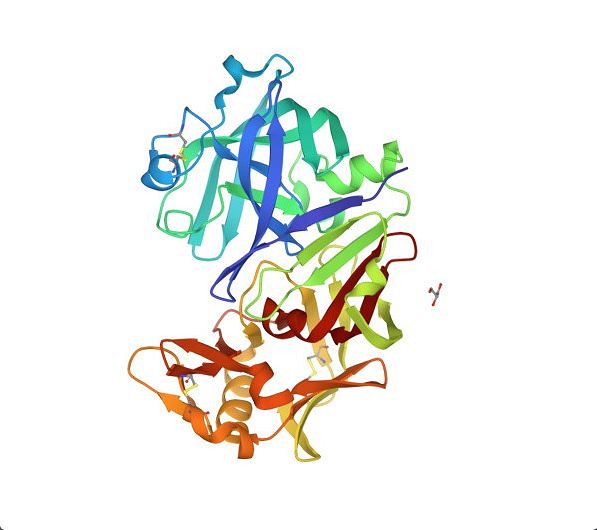Scientists from Altai State University, as part of a large research team, deciphered the three-dimensional structure of Altai deer chymosin
Scientists from Altai State University, together with colleagues from Novosibirsk, Koltsovo, Ufa, and Moscow, have deciphered the three-dimensional structure of recombinant Altai deer chymosin.

Recombinant Altai deer chymosin is an enzyme completely analogous to those secreted by the gastric mucosa of fawns during milk feeding. It is able to substitute imported preparations of recombinant milk-clotting enzymes widely used in cheese making.
Scientists from the Research Center "Prombiotech," the Russian-American Anti-Cancer Center, the Institute of Biology and Biotechnology represented Altai State University in the project. Together with physicists, mathematicians, bioinformaticians, biologists, and biotechnologists from other scientific organizations, they managed to replenish the PDB (Protein Data Bank), they deposited the spatial structure of the recombinant Altai deer chymosin in the PDB (Protein Data Bank) - this is an international data bank of three-dimensional protein structures. By 2023, only two structures of chymosins, bovine and camel, were submitted to the PDB. Our scientists were third.
“There are two large scientific repositories in the world where data on nucleotide sequences is stored - this is GenBank, for proteins this is the PDB. If GenBank has millions of records about different genes, genomes, etc., then the PDB has much less information, because deciphering the structure of a protein is two times more difficult. At the first stage, we must find the amino acid sequence of the protein, then obtain, purify, isolate this protein in such a way as to obtain a preparative amount of this protein in order to obtain a crystal and then understand its three-dimensional structure,” said a leading researcher of the RAACC, Candidate of Biological Sciences, an associate professor Dmitry Shcherbakov.
Scientists from Altai State University have been working on recombinant enzymes for several years now.
“From the very beginning of this work, we assumed that sooner or later we would get a three-dimensional structure for the chymosins of the mammals under study. Altai deer chymosin was the first in this series. We managed to do more than just get this protein in the right amounts to make cheese. We obtained pure protein and grew a crystal. This work was carried out jointly with physicists from Akademgorodok in Novosibirsk. Based on the crystal, it was possible to obtain a diffraction pattern - this is when the crystal is exposed to certain radiation and they watch how these rays scatter when passing through the crystal. The resulting diffraction pattern had to be deciphered - this work was also carried out by colleagues from Akademgorodok and the Moscow Institute of Physics and Technology. In fact, it was possible to reproduce the three-dimensional structure from the numbers (dispersion data)," said Dmitry Shcherbakov.
With the help of a three-dimensional model, scientists expect to get closer to understanding the subtle mechanisms of the enzyme. For example, to find out why it is more thermally stable than its analogue. Knowing the three-dimensional structure, one can suggest how to change the enzyme in order to improve its properties.
“It was a complex work, a large team from Altai State University participated in the project - these are scientists from Prombiotech, and a lecturer at the Department of Ecology, Biochemistry and Biotechnology of IBB Dina Balabova. The role of the ideological inspirer of the study of the three-dimensional structure of enzymes, Head of the Department of Physical and Chemical Biology and Biotechnology, Academician of the Russian Academy of Sciences, Doctor of Chemical Sciences, Professor Olga Lavrik, cannot be overestimated. Our result is not final. We will also obtain other chymosins, next in line are chymosins from tupai, argali, roe deer, etc. And, of course, we will strive to obtain their three-dimensional structures,” Dmitry Shcherbakov summed up.